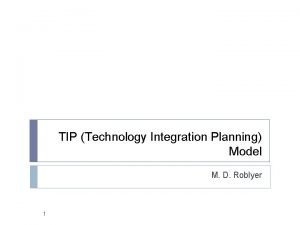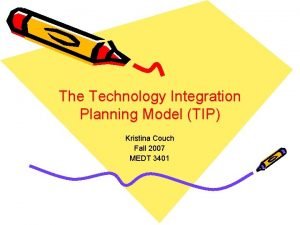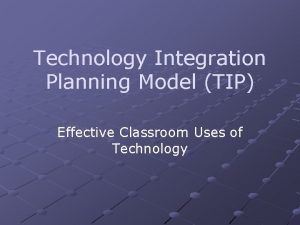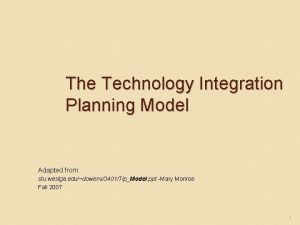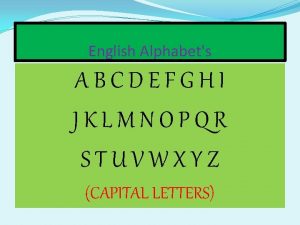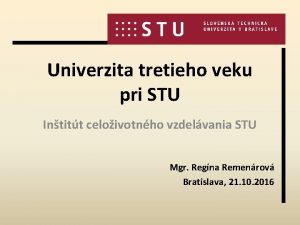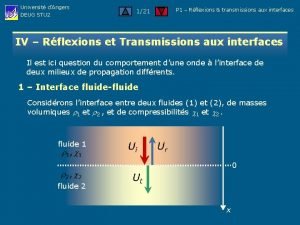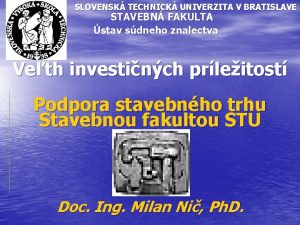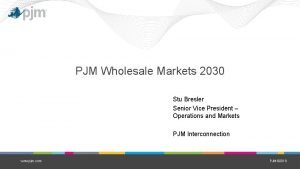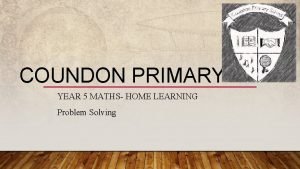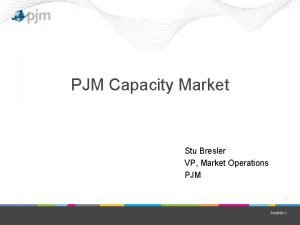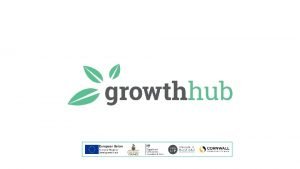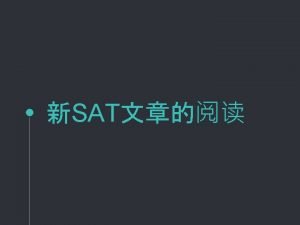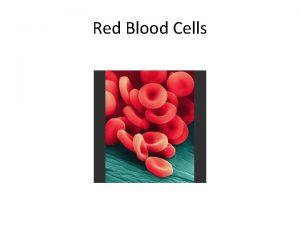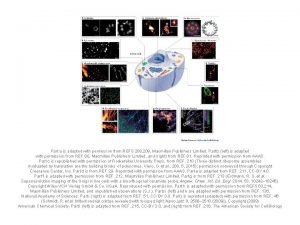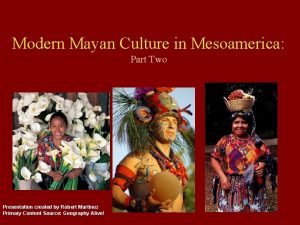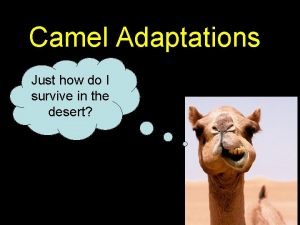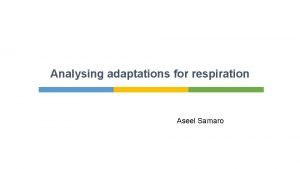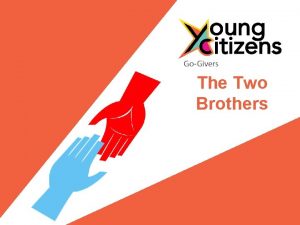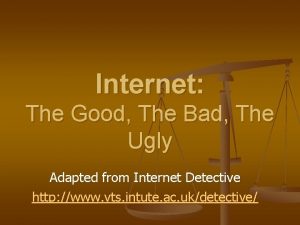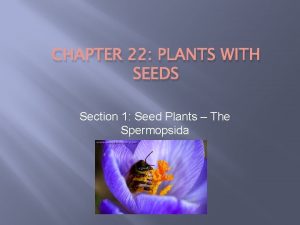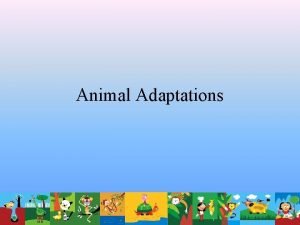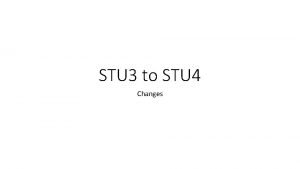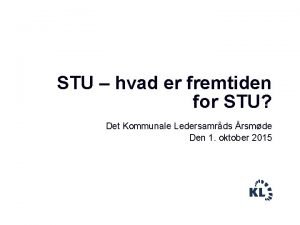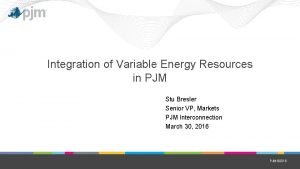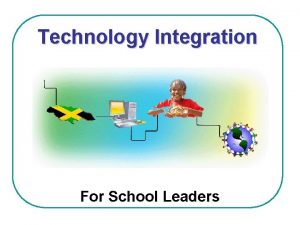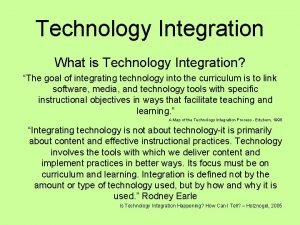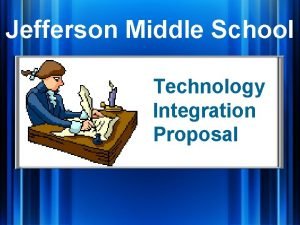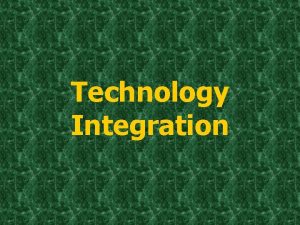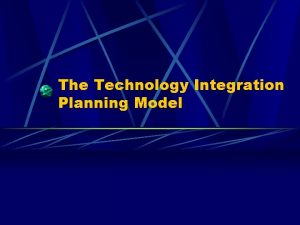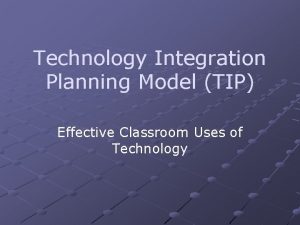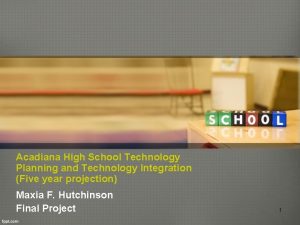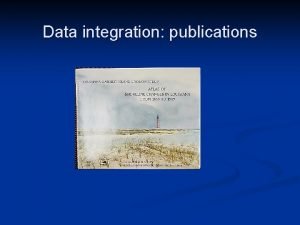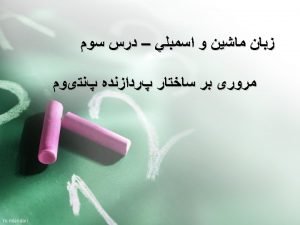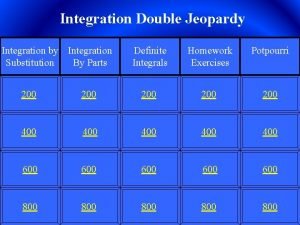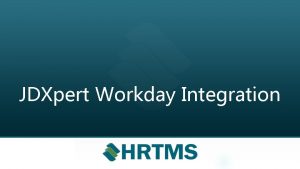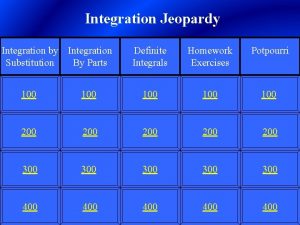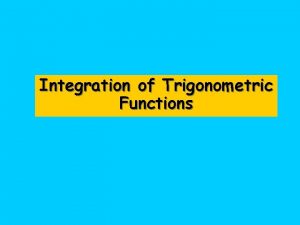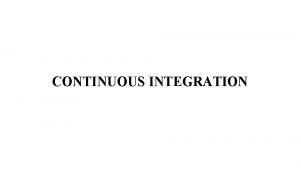The Technology Integration Planning Model Adapted from stu































- Slides: 31

The Technology Integration Planning Model Adapted from: stu. westga. edu/~dowens/3401/Tip_Model. ppt -Mary Monroe Fall 2007 1

Hierarchy of Considerations �Four ◦ ◦ aspects of technology skills Operational Functional Strategic Social Adapted from Janice Light “Toward a Definition of Communicative Competence for Individuals Using Augmentative and Alternative Communication Systems” Journal of AAC, 1989, p. 137 -143 2

Operational Skills �Technical skills required to operate the device or system �Includes skills to use the access method Operational Skills: -Teacher How the technology works How to manage and maintain the technology 3

Functional Skills Mastery of the specific knowledge or abilities for which the device was chosen. Teacher Teaching with the technology as part of instruction Teaching someone to use technology Student Know what to do with it 4

Strategic Skills �Decide when to use the tool �Choose which tool to use for a specific activity or task Teacher Skills: Knowing when to use technology Student Knowing when to use it and when not to use it 5

How to help others understand reasons for use of AIM and AT Social Skills �Use technology where others are present �Use technology with others �Help others understand the reasons for and use of the technology Social Skills Teachers: How to manage a classroom where students use technology How to help others understand reasons for use of AIM and AT Students: Knowing how to use in a social and real-world context 6

Hierarchy of Considerations �Four ◦ ◦ aspects of technology skills Operational Functional Strategic Social Adapted from Janice Light “Toward a Definition of Communicative Competence for Individuals Using Augmentative and Alternative Communication Systems” Journal of AAC, 1989, p. 137 -143 7

Step 1: Determine Relative Advantage �Step 1 Questions ◦ What is the problem I am addressing? �Do not focus on technologies �What is the curriculum content? �What 21 st century learning skills will be addressed? �What tasks do I want the student to engage in? �Look for evidence ◦ Do technology-based methods offer a solution with sufficient relative advantages? 8

Step 1: Determine Relative Advantage �Estimate the impact �Consider the required effort and expense �Does this strategy support 21 st century learning and UDL initiatives? 9

Step 2: Decide on Objectives and Assessments � Example outcomes, objectives, and assessments ◦ Critical thinking ◦ Problem solving ◦ Collaboration ◦ Innovation ◦ Creativity ◦ Communication � Step 2 Questions ◦ What outcomes do I expect from using the new methods? �Focus on results, not process �Observable and measureable 10

Step 2: Decide on Objectives and Assessments ◦ What are the best ways of assessing these outcomes? �Provide student with multiple means of expression �Use written test to assess skill achievement outcomes �Computer generated outcomes �Use evaluation criteria checklists to assess complex tasks or products �Use rubrics to assess complex tasks or products 11

Step 3: Design Integration Strategies �Deciding on teaching/learning methods ◦ Use directed and constructivist strategies ◦ Assistive technology �Accessible Instructional materials �Step 3 Questions ◦ What kinds of instructional methods are needed in light of content objectives and student characteristics? �Content approach �Grouping approach �Whole class, individual, pairs, and small group 12

Step 3: Design Integration Strategies ◦ How can technology best support the IEP goals and objectives and the curricular tasks? ◦ How can I prepare students adequately to use technologies? �Prepare and teach students before graded product �Measure content not ability to use the technology 13

Step 4: Prepare the Instructional Environment �Essential conditions for effective technology uses ◦ Adequate hardware, software, and media ◦ Time to use resources ◦ Special needs of students ◦ Planning for Questions ◦ What equipment, software, media, and materials will I need to carry out the instructional strategies? �Computers �Copies of software and media �Access to peripherals �Handouts and other materials 14

Step 4: Prepare the Instructional Environment ◦ How should resources be arranged to support instruction and learning? �Access by students with disabilities �Provide for: �Visibility �Avoid distractions �Access to materials �Classroom organization that supports the activities �Privacy and safety issues ◦ What planning is required to make sure technology resources work well? �Troubleshooting �Test-runs and backup plans 15

Step 5: Evaluate and Revise Integration Strategies �Evaluation issues ◦ Were objectives and outcomes achieved? ◦ What do students say? ◦ Could improving instructional strategies or the environment improve results? ◦ Have I integrated technology well? 16

Step 5: Evaluate and Revise Integration Strategies Questions ◦ How well has the technology integration strategy worked? �Achievement and attitude data �Students’ comments ◦ What could be improved to make it work better? �Scheduling �Technical skills �Efficiency 17

Instructional Strategies �What instructional content and strategies will be needed for the student to use the materials effectively? �Understanding general ed initiatives �Understanding the teacher’s personal focus and priorities �Helping to create a shared vision of how technology can be supported Gayle Bowser(gaylbowser@aol. com Closing the Gap 2010 18

Differentiation �Planning and delivery of instruction that addresses the varied levels of readiness, learning needs, and interests the student �Guiding principles ◦ ◦ Ongoing assessment Timely adjustments Respectful tasks Flexible grouping Gayle Bowser(gaylbowser@aol. com Closing the Gap 2010 19

Differentiation Based on Student’s �Readiness �Interests �Learning profile Gayle Bowser(gaylbowser@aol. com Closing the Gap 2010 20

Student Readiness �Levels of Participation ◦ Competitive ◦ Active ◦ Involved ◦ None Gayle Bowser(gaylbowser@aol. com Closing the Gap 2010 21

Student Interest �Topical groups �Student choices �Project based learning Gayle Bowser(gaylbowser@aol. com Closing the Gap 2010 22

Learning Profile �Visual learner �Auditory learner �Learns best in alone groups �Self directed �Needs guidance �Active learner �Reflective learner �Concrete �Abstract learner 23

Differentiation �Take a closer look at accommodations/modifications �What affects learning the most is how well classrooms are managed �Gives teachers more time to teach �Part of the reason for issue with technology is that it takes away from the time they have to teach. . to learn it Gayle Bowser(gaylbowser@aol. com Closing the Gap 2010 24

Classroom Management #1 factor affecting student learning 25

Estimated use of school time Hrs/Day Hrs/Year Total available time 6 1080 Academic learning time Engaged time 0. 6 -1. 5 108 -270 1. 5 -3. 5 270 -430 Attendance time 5. 4 -6. 0 970 Berliner’s Beginning Teacher Evaluation Study (G. Bowser CTG 2010) 26

Classroom Management �The actions teachers take to create, implement, and maintain a classroom environment that support learning include: ◦ ◦ ◦ Classroom organization Rules procedures and goals Anticipatory set Relationships Behavior Carolyn M. Evertson “Classroom Management” in Psychology and Educational Practice Eds. Walbberg & Haertel, 1997 27

Classroom Organization �You can tell a lot about how teachers teach by the seating ◦ Teacher centered ◦ Teacher down the center aisle ◦ Centers/cooperative learning, interaction Gayle Bowser(gaylbowser@aol. com Closing the Gap 2010 28

Classroom Organization for Accessible Instructional Materials �Look ◦ ◦ ◦ for these features: Visibility Distractibility Access to technology Access to materials Classroom organization that supports the activities �Can the teacher see the student and what the student is doing? Gayle Bowser(gaylbowser@aol. com Closing the Gap 2010 29

Revisit �Go back to the question— ◦ what change in student’s performance do we hope to see? �Look back at the previous expectations ◦ don’t expect changes if the supports the kids are used to don’t change Gayle Bowser(gaylbowser@aol. com Closing the Gap 2010 30

Resources � Bowser, G. & Zabala, J. 2010. Helping teachers integrate AIM in classroom instruction. Closing the Gap Preconference. � Light, J. 1989. Toward a definition of communicative competence for individuals using augmentative and alternative communication systems. Journal of AAC, p. 137 -143. � Monroe, M. 2007. Technology Integration Plan Fall 2007 http: //stu. westga. edu/~dowens/3401/index. html 31
 Tip model educational technology
Tip model educational technology Technology integration planning model diagram
Technology integration planning model diagram Technology integration planning (tip) model
Technology integration planning (tip) model Technology integration planning model example
Technology integration planning model example A b c d e f g h i j k l m n o p q r s t u v w x y z
A b c d e f g h i j k l m n o p q r s t u v w x y z Utv stu
Utv stu Stu 2
Stu 2 ústav súdneho znalectva stu bratislava
ústav súdneho znalectva stu bratislava Stu bresler
Stu bresler Stu cabe
Stu cabe Maths frame stone age stu
Maths frame stone age stu Stu bresler
Stu bresler In the diagram ghj = stu
In the diagram ghj = stu Stu sjouwerman
Stu sjouwerman Stu anderson
Stu anderson Fei moodle
Fei moodle This passage is adapted from jane austen
This passage is adapted from jane austen How are red blood cells adapted
How are red blood cells adapted Adapted with permission from
Adapted with permission from In what ways have the highland maya adapted to modern life?
In what ways have the highland maya adapted to modern life? Xerophytes adaptations
Xerophytes adaptations Chaparral biome location
Chaparral biome location Camel adaptations for survival
Camel adaptations for survival Sausage shaped organelles
Sausage shaped organelles Brother quotes from brother
Brother quotes from brother Adapted from the internet
Adapted from the internet Gallant
Gallant How have plants adapted to the rainforest
How have plants adapted to the rainforest Spermopsida plants
Spermopsida plants The outsiders adapted for struggling readers
The outsiders adapted for struggling readers Internal synoynm
Internal synoynm How are giraffes long necks adapted to their lifestyle
How are giraffes long necks adapted to their lifestyle
